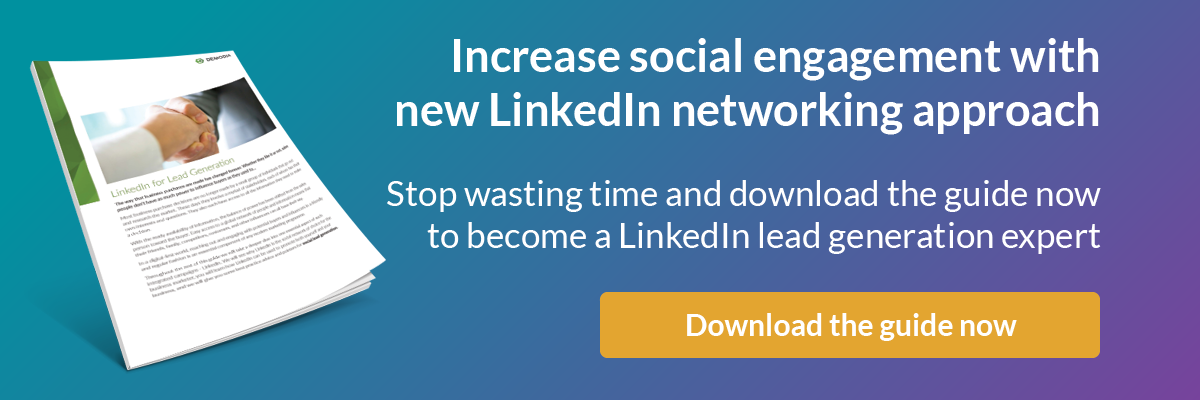
No other social medium promises as many high-quality leads as LinkedIn. The platform with 830 million users worldwide can strengthen credibility and increase visibility. For B2B companies in particular, LinkedIn is the platform with the greatest chance of achieving results. Yet many companies shy away from taking the step of using LinkedIn as a marketing tool. Why is that?
LinkedIn's algorithm loves consistency. It sends content from companies that post regularly to the pole position of user feeds. Regularity is the signal for LinkedIn that the brand is engaged and active.
But it's not just frequency that determines whether you can cross the finish line ahead of the competition on LinkedIn, but also the relevance of the content. The more interesting the posts are for the users, the more the expert status and trust in the brand is cemented.
Many companies, especially smaller ones, think it is too costly to constantly produce new, high-quality content. With our storytelling method, we show how you can produce numerous relevant content and thus achieve not only credibility but also an emotional connection to the brand.
Step 1: The user is the hero of the LinkedIn hero's journey
In storytelling, the customer, on LinkedIn the user, is the hero of the story. Before a brand sends its users on the hero's journey, it should get to know its heroes, aka users, in detail. In other words, define the target group.
To do this:
- Use customer personas that you have already created for your brand.
- In the free tool LinkedIn Analytics, you can find information on the age, gender, location and professional experience of your followers, which can help define the target group.
- Join LinkedIn groups that are relevant to your brand and target audience. This will help you gain insights into what topics your target audience is engaged in and what trends are currently being discussed.
- Identify LinkedIn hashtags that your target group uses.
Step 2: The problem of your hero, aka user
Once you have identified your hero (group), be clear about what problem you are solving for your target audience. Consider the problem on three levels:
- External: first, define the external problem your brand is solving.
- Internal: Put yourself in the shoes of your users and be clear about the emotions the problem is causing.
- Philosophical: Identify how your brand solves what should not be.
Your customer's problem can be a source of LinkedIn content in many ways.
- Create informative articles or tutorials on how your brand solves the problem.
- Create posts with the three levels of your customer's problem (and offer the solution).
- Ask questions: identify problems by asking your customers and then providing the answers.
- Gather feedback on your customers' problems with interactive infographics and quizzes.
- Tell customer success stories. Start with the problem and end with the solution.

Step 3: Be the guide
Your role in storytelling is to be the mentor. Be Yoda from Star Wars, who spent centuries as a Jedi Master, passing on his knowledge and wisdom to students.
Show how you solve your client's problem. Your attitude in doing so is comparable to Yoda's:
- With empathy. You understand your customers and therefore bring the maximum result.
- With authority. You have the appropriate experience, methods and awards to solve the problem.
Your role as a guide can be translated into LinkedIn content in the following ways:
- Share your team's expertise: showcase your team members' expertise by sharing your blog posts, articles or presentations. Explain why these insights are valuable.
- Introduce your team and explain their expertise.
- Announce any awards, recognition or prizes your brand has received.
- Publicise industry news and trends: Share relevant news and trends from your industry and add your own commentary or analysis.
- Describe the evolution that has led you to where you are today.
Step 4: You have a plan
As a mentor, it is your job to show exactly how you can solve a problem. Only you have the key to the problem: the plan. In the same way, Yoda realised Luke Skywalker could save the Empire and developed a plan: he took him under his wing and trained him in the Jedi arts.
Your job now is to give your clients a plan.
How can you translate your plan into LinkedIn content?
- Show how your customers solve your problem in how-to articles, guides or tutorials.
- Publish case studies: Use a specific example to show how a problem was solved.
- Offer free resources such as e-books, white papers or guides that focus on solving the problem.
- Make your experts available. Make sure your experts are present on LinkedIn to address the customer's problem.
- Create a campaign around the problem, such as HubSpot did: HubSpot launched a LinkedIn campaign called "Inbound Marketing." With blog posts, webinars and guides, they showed followers how to improve their marketing strategies and increase sales.

Step 5: Show the world as it looks after the problem has been solved.
The main essence of storytelling is transformation, the engine of it all. Luke Skywalker evolved from a simple farm boy to a Jedi Knight who saved the Galaxy. Tony Stark went from a rich arms dealer to a man who uses his technology to fight crime in Iron Man. Erin Brockovich begins her journey as a chaotic, troubled single mother and ends as a confident and successful fighter against an energy company. The list could go on indefinitely because, without transformation, there is no story. But how can brands showcase their customers' (positive) transformation in LinkedIn posts?
- Share customer reviews and complement them with a paragraph outlining the customer's problem and how your brand solved it.
- Showcase with statistics and data how many customers you have helped.
- Post customer statements expressing the customer's competence and satisfaction.
- Post case studies showing the positive results your brand has brought to the customer.
- Produce a video in which your customers have their say and share their success stories.
Storytelling offers you a variety of content opportunities with the advantage that you always stick to your "red thread". Through storytelling, you can create an emotional connection with your target group, impressively present the benefits of your brand and increase your credibility. Stringent storytelling can also clearly differentiate you from your competitors.
At Demodia, we have been combining storytelling with technology for decades. For example, we link your storytelling strategy to Hubspot so you spend less time on content creation, posting and evaluation. Do you have questions about how you too can use storytelling efficiently? Book an appointment here, because your story can become a bestseller on LinkedIn.


